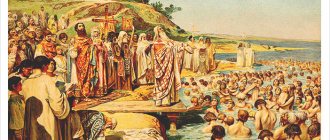SHOULD ORTHODOXY BE MODERN?
Estimated reading time: 8 minutes.
Evgeny Mironov, People's Artist of Russia, artistic director of the Theater of Nations, Moscow
The church should not be a museum
I once asked a priest I knew: “What to do with the fact that I, and many others, do not understand the language of worship?” Father answered me that the Church Slavonic language is very important, that it was preserved in all its originality only in the Church. And opening a book and learning unfamiliar words is, of course, work, but it’s quite feasible work. But... to be honest, I didn’t open the book after that.
I heard that there is a church in Moscow where services are conducted in modern Russian. I think this is good, because it gives a person (especially a young person taking his first steps in the Church) the opportunity to understand the essence of the service, and not just stand in the church, mesmerized by its beauty and melody. There should always be a choice.
Regarding missionary work: I do not believe that speaking to young people in their language is a crime against the Church and faith. Of course, one must know moderation in everything, but, without a doubt, being a museum is much worse for the Church: traditions will remain intact, and the souls of many young people will remain behind the fence.
Vladimir Kulygin, Doctor of Law, Professor, Khabarovsk State Academy of Economics and Law, Khabarovsk
Modern means close to people
To me
, it is difficult for a person who was baptized quite recently to say what “modern Orthodoxy” is, because I simply don’t know anything else. But I can assume that “non-modern Orthodoxy” in modern Russia is the option when the revival of Christianity is understood as the restoration of the church structure and personal life according to pre-revolutionary books, or when “reprinted” answers are given to modern questions of people coming to church.
The appearance of Orthodoxy largely depends on the attitude of the clergy. It is gratifying that we increasingly see priests freely communicating with people in any circumstances: in a church, at a tram stop, at a fashion installation in a museum. When a pastor knows the needs of the modern world and sensitively responds to the needs of believers, then Orthodoxy becomes closer to people, then it becomes modern.
Orthodoxy should not and cannot be a “one-way street.” It is absolutely obvious to me that the more the clergy goes to the people, the more people will understand that life in the Church is a living life filled with spiritual meaning. And the more people make it their life, the more modern it will be for those around them.
Sergey Khudiev, publicist, director of the Library of Christian Literature, Moscow
Faith is a risky business
Jesus Christ
The same yesterday, today, and forever (Heb. 13:8), and the Gospel which the Church proclaims remains the same. Centuries pass, languages and cultures change, powerful empires form and fall apart - but the main thing, in essence, remains unchanged. people do not cease to be lost sinners, and Christ is a true and faithful Savior, Who abides in His Church to save those who come to Him with repentance and faith.
We live in a world with its changing political, intellectual or religious fashions, with numerous "isms", each of which - be it nationalism, feminism, "new age" or anything else - sees itself as having finally found a higher truth and wanted to subordinate, adapt and edit the Gospel in relation to their needs. That is why we are commanded “not to be conformed to this world.”
However, there is another danger - the absolutization of one of the past centuries in the history of the Church, when the heritage is not so much spiritual as cultural, it becomes something more important and valuable than the salvation of people. I think (I don’t remember, maybe I read it from someone) that the words of the Apostle “do not be conformed to this age” do not mean “but instead be conformed to the 8th, or 16th, or 19th century.” Rather, they mean that we must conform to the everlasting gospel, which is not tied to any particular era or culture. It will not be possible to completely follow even the most venerable examples of the past: the people to whom we are sent simply will not understand us. And here you have to take risks, do something in a way that has not been done before, incur the reproaches of sincere and zealous people, but deeply committed to a certain church culture.
Faith is a risky endeavor; it is impossible to secure it, I would even say that trying to secure it is dangerous. Let us remember the parable of the talents. The servant who hid his Lord's silver in the ground seems to have chosen the safest course of action. He reliably kept what was entrusted to him. He was guided by fear - lest he incur the wrath of the Lord, and he did so. The other two, as we would now say, embarked on adventures. They acted at their own peril and risk - but in the end it is them who the Lord praises. They weren't thinking about how to avoid punishment; they were thinking about how to serve their Lord.
Egor Kholmogorov, publicist, Moscow
We are strangers to modernity
Let's understand a little about the word “modern”. When we say that Russia must have a modern army, that is, be ready for a future war, and not for the past, and those who prepare for the last war will lose, then in this sense of the word Orthodoxy must always be modern. Our battle is not against flesh and blood (Eph 6:12), our spiritual war is already underway, and its main global battle is in the future. For this spiritual war, we must be equipped with the most effective means, be they even a hundred or a thousand years old. But we should not cling to something that cannot help in our war for human souls, even if this “something” has a long and venerable history.
However, the word “modern” is usually used in a different, and partly evaluative, sense. Modern means corresponding to the era of modernity, the “new time”, when people decided that they could build paradise on earth, without God and the Kingdom of Heaven. The main means of building this new paradise was the invention of more and more “innovations”, more and more new ways to circumvent the fundamental laws of existence. There is a whole mythology of “modernity” - fashion and freedom from prejudice, “creativity” and “advancement”. And the relationship of such “modernity” with Orthodoxy is much more complicated. We Orthodox Christians are ready to survive in any era and continue our work. But no matter what ultra-fashionable clothes we dress up in, we are still strangers to modernity if we “preach Christ Crucified.” The idea of Christianity and the idea of modernity are opposites.
Another thing is that the idea of modernity, even in the zombie shell of postmodernity, is already running out of steam and dying. We live at the beginning of a new, completely different era. And in this sense, “to be modern” according to the patterns of modernity for Orthodoxy would mean becoming obsolete.
Alexander Grebenko, director of KFK LLC, St. Petersburg
Become contemporary with Orthodoxy
I have noticed that Orthodoxy is often called “the faith of old women.” Indeed, there are usually more elderly people in churches than young people. But does this mean that Orthodoxy is not modern? I think it's something completely different. The path to faith is always long and difficult, and, unfortunately, we learn exclusively from our mistakes: until we commit a sin ourselves, we will not understand what it leads to. That’s why we begin to think about God only with age, and we often come to Church when we are already middle-aged...
The main problem, in my opinion, is that today people are embarrassed to talk openly about their faith, they do not feel it as something natural for themselves. Probably, these are the consequences of many years of persecution of the Church... Another question is important to me: “How can we become contemporary with Orthodoxy?”
Dmitry Zaitsev, Chairman of the Board of Directors of the Managing Director, Moscow
You can't adapt to the jargon
The picture of the world is constantly changing: instead of horses there are cars, instead of goose feathers there are computers; but the person essentially remains the same. Orthodoxy is modern because it speaks about the most important things: the relationship between man and God, soul and eternity.
Without a doubt, priests must be able to find a common language with young people. Do not stoop to a primitive level, of course, but respectfully and sensitively listen to everyone who comes for advice, try to lift the person to a higher level. But I think there is no need to modernize the language of worship. Modern language is degenerating, and this process is irreversible - it will only progress. Will the Church have to constantly adapt to every new jargon that claims to be the norm? The Church Slavonic language is not accidental: it contains everything: mysticism, beauty, and those roots that we so lack today.
Priest Dimitry Karpenko, deputy editor-in-chief of the youth journalistic magazine “New Ark”, Belgorod
Inside and outside
It depends on what you mean by “modern Orthodoxy.” If we talk about the Church’s use of modern technologies, then, in my opinion, this is not worth discussing. Priests and Orthodox laity communicate today on the Internet and speak modern language; they do not reject the achievements of technological progress, and cannot reject them. It’s the same as if the Holy Fathers of the Church refused to use paper to record their teachings!
I will say more: it seems to me that there is nothing terrible if, taking into account the serious preparation and blessing of the Church, someday we will have divine services in Russian and a new translation of Scripture will be released, close to modern language norms. Here the only question is the giftedness and talent of the translator, and of course there is no fundamental prohibition on this.
But our faith must remain the same as that of the apostles and Holy Fathers. And this is the main condition. What does not concern the essence of the doctrine can change, but if we forget what the main meaning of church service is, reject God or try to somehow change our view of Him, our faith will cease to be Christianity. Even if the external attributes remain unchanged.
Priest Nikolai Emelyanov,
Deputy Dean of the Faculty of Theology of PSTGU, Moscow
Freedom not to march in formation
Answer
The answer to this question fundamentally depends on the understanding of the word “modern”.
Lewis has a wonderful observation about the interpretation of this concept. He writes that often when a girl says that she “wants to be modern,” it means that she wants to be “a slut and a fool.” This sounds somewhat rude, but, unfortunately, in some cases this definition remains relevant. In this sense, Orthodoxy will always be unmodern, since it will always resist the spirit of this world, living separately from it and independently.
Orthodoxy cannot “keep up” with the times, because it leads to absolute freedom, and not to walking in line. But at the same time, Orthodoxy cannot help but be modern in the sense that it is always relevant. It penetrates into all forms of life in this world, not mixing with it, but transforming it. It should and does provide answers to vital questions that each era poses in a new way and which require new and convincing answers.
On the screensaver is a fragment of a photo from surfingbird.com
Why the clergy does not accept new forms
Makarov: There are historical, sociological, anthropological, theological, philosophical and a number of other reasons. To summarize, modern church building was largely influenced by the history of the 20th century. The desire to restore what was lost after the change in policy in the 90s overlapped with a period in architecture in which deconstruction and citation were part of the main tools of architects.
The found approach to church architecture turned out to be so successful and appropriate over time that it is not easy to overcome it. It is not enough to say “we need modern churches, because we live in the 21st century,” for this it is also important to have a theological, philosophical justification for the surrounding cultural processes, which will provide additional support in the creation of forms.
Perhaps the topic of theoesthetics, which has developed in recent years in the church academic environment, will take the understanding of church art to the next level, but for now we have the argument of escapism and the fight against modernism.
Yakubchuk: A significant part of the Orthodox community perceives very sensitively, in fact, an absolutely everyday issue of the church life of a separate parish. On the one hand, this is a consequence of the centralization of church power: the everyday issue of a separate parish for some reason becomes the central topic for discussion of the entire community. On the other hand, this is a side feature of our neophyte.
We tend to perceive the entire church structure in an isosacral way. That is, for us, at first, the commandments of Christ, the shape of the candlesticks in the temple and the random words of grandma on the candle box are equally sacred. We take everything so close to our hearts that we consider it all unshakable. It turns out to be a paradox. The inability to generate new forms in church architecture and church arts is a consequence of our “church youth”: the number of active believers has grown rapidly over the past 30 years, all this is still new for us, and we are not yet able to independently create new forms of church life without looking back at the past. life and church culture. We'll get there.
Why did the transition to modern forms happen much earlier in the West?
Makarov: In the West there has always been a progressive development of church architecture in parallel with the development of all other art and culture, without any dramatic transitions. There were no historical factors that would remove church art from the sight of cultural figures.
Yakubchuk: I don’t think there was any special transition there. There is a progressive evolutionary process underway, not greatly disturbed by global upheavals, as was the case with us. Still, the persecution of the church in Soviet times was a powerful tectonic shock, according to some estimates, surpassing even the Roman persecutions of early Christian times. We as a society have not yet recovered from those traumas; architecture is only a consequence of this trauma. While we intensely yearn for the lost past.
XXI - the world has really changed
In man, from the moment he fell away from Eternity, the desire for development was always present - this is how hard everyday life became easier. But at the end of the 20th century the Internet appeared and the development of digital technologies accelerated. They made our lives fundamentally different - due to the scale of their influence.
- Firstly, the very speed of life. It has become such that a person physically does not have time to look inside himself.
- Secondly, the entertainment industry (and advertising, and with it all branding) has penetrated so deeply into our lives that sometimes (at least in the city) it seems that there is nothing else besides it.
- Thirdly, people who are at the head of the entertainment and mass media industries themselves most often do not live a spiritual life and do not understand this side of life, and therefore involuntarily present religious people as strange and backward, who should be pitied because they supposedly they are losing a lot.
- Fourthly, the development of digital technologies has allowed an essentially irreligious, bustling world to penetrate everywhere and into every moment of our lives.
- Fifthly, even the deepest art itself (poetry, fiction, deep films) ceased to carry reflections about eternity - rather, reflections about man himself. The substitution lies so deep that for many it is art that has become a source of religious experience and self-discovery.
The world is increasingly limited by man himself, removing the mystical principle from his life.
All this happened before. But never in history - say, even in the most dissolute times of the Roman Empire (a conditional example!) - has it embraced the human superconscious on such a scale. And from this point of view, modern man - a man from a big city - is truly a very special picture. A person finds himself in conditions where it sometimes seems that he simply has nowhere to go except to continue living in the hustle and bustle, the world of advertising, entertainment, speed and pervasive digitalization. Which, in turn, captures everything and does not leave even the thought that True existence can be completely different, and true happiness can be felt outside of all this...
Is the Church really out of step with its time and does not find the right words for the exhausted (or not yet exhausted) city dweller?
Is Russia ready for such experiments?
Makarov: So far, it’s more likely no than yes, but in the “200 temples” program there is feedback on the results of construction: the standard first-wave temples, made using the prefabrication method, turned out to be very inflexible and not as cheap as expected. The churches of the second wave were not typical and more consistent with the needs of the parish, but at the same time they used the old approach to development, which did not always make efficient use of the territory. Now we see experiments with the layout of churches and parish buildings, I think that soon the aesthetic problem will also be in the spotlight.
Yakubchuk: I think we are still at the stage of accumulating requests for new forms. This demand grows naturally through a change of generations and sooner or later will lead to the emergence of truly new forms. Paper projects are very important in this process. While these churches are gathering their virtual flock in the form of comments: “Wow! I would go/went to such a temple!”
MAIN trends in church construction
Makarov: There are several trends, some of which are associated with the next revision of history and the use of those historical architectural forms that have not been interpreted so often over the course of three decades.
For example, the Church of the Intercession in Yasenevo “closed the gestalt” with a Russian-Byzantine theme. It is unclear whether the “imperial” direction will have a long continuation after the Cathedral of the Sretensky Monastery, the Church of the Armed Forces and the Church of St. Prince Vladimir in Tushino.
Church of the Intercession of the Blessed Virgin Mary in Yasenevo. Source: Andrey Kolychev / panoramio.com
We can especially highlight two emerging directions that can become the main ones: small, low churches, which are easier for the community to maintain, and church-complexes, which in one simple or developed volume contain premises for both worship and parish activities. The first includes the Church of Seraphim of Sarov in Kozhukhov, the second - the Church of St. Ignatius the God-Bearer in Novogireevo and the Church of St. Sergius of Radonezh on the Khodynka field.
Yakubchuk: For myself, I distinguish the following trends in modern church construction: grandeur, fabulousness, utilitarianism. Greatness is intended to amaze in scale, to demonstrate strength, power, and rootedness in space and time. Typical representatives are the Cathedral of Christ the Savior and the new cathedral in the Sretensky Monastery. It seems to me that these are mainly projects related in one way or another to the state.
Church of the Resurrection of Christ and New Martyrs in Sretensky Monastery
“Fairy-tale” temples are characterized by historical forms, realized through the graphic culture of the Art Nouveau or modern fantasy era, depending on the outlook of the authors and customers of the project. The best temples of this direction seem to have come out of Bilibin’s illustrations. These are the projects of the master of today's temple construction, Andrei Anisimov. In a sad case, we get a temple in Peredelkino. It would seem unfair to put these temples on the same line: some are academic and subtle, others are distilled kitsch. However, they have a common desire to appear in a fairy tale and pretend that the bloody 20th century for the church never happened at all. These are usually sponsored or ordinary temples of the 200 Temples program.
Princess on the tower tower. Illustration for the fairy tale “The White Duck”. Ivan Bilibin. Source: artchive.ru
Illustration for the epic “City of Kitezh”. Ivan Bilibin. Source: artchive.ru
The third direction is utilitarian. In it, I would combine all attempts to resolve the issue of building a church using minimal means with the help of a living parish community. These are all kinds of trailers, wooden temporary temples, adaptation of household premises for temples, construction of economical temples in the simplest forms.
People here often solve pressing problems of church life without the participation of an architect and often find quite elegant and simple solutions. This direction seems to be the most stable and promising. Its practices are the least ideological and the most practical. It's not always pretty, but it always works.











